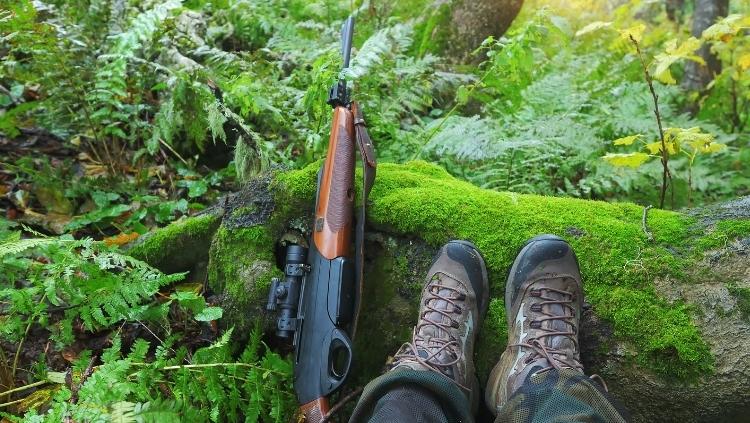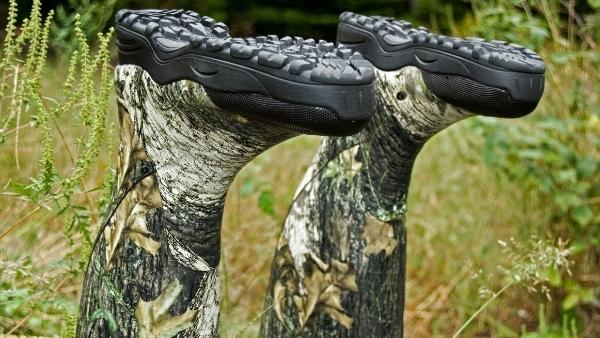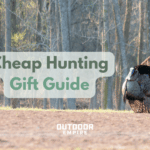Avid hunters understand the importance of having well-fitting boots. If you’re focused on how uncomfortable your feet are during a hunt, you probably won’t be successful at nabbing game. Ill-fitting boots can also leave you with painful blisters and make you more prone to accidents and injuries due to the lack of protection.
Hunting boots should fit snugly around the ankle and instep, have a footbed that secures the bottom of your foot without sliding, and have space in the toe box so you can wiggle your toes. Depending on the intended use and terrain, boots that are a half size bigger are often recommended.
Finding hunting boots that fit perfectly is important for a successful hunting excursion. If you want a good hunting boot fit, here are a few questions and tips to show you how hunting boots should fit.
First Consider Terrain and Weather for Hunting Boot Fit
The most important thing to remember when finding the right pair of hunting boots is that all boots are not created equal. You need boots specifically designed for the environment you regularly hunt in.
Athletic-style boots may be great for traipsing through the backcountry, but they won’t keep your toes toasty warm in the winter.
Related: Best Hunting Boots Reviewed
It’s essential to carefully consider your regular hunting environment to decide which type of hunting boots is right for you. A few environments and conditions you may hunt in include:
Cold Weather
If you often hunt during freezing temperatures, you need to keep your feet warm and dry. Cold-weather boots with extra padding and insulation may be necessary to keep your feet warm enough.
Warm Weather
You don’t need insulated boots when it is warm outside. Opt for breathable boots that are flexible and versatile, so your feet stay cool while you travel through the backwoods.
Upland
Tough, durable boots are essential for protecting you from snakebites when you hunt upland game.
Mountains
Flexible shoes are not suitable if traveling over rocky or mountainous terrain. You need boots that offer your ankles superior support to minimize the risk of accidents.
Water
If you’re duck hunting near the water, you need a pair of mud boots or waders to keep your feet dry.
When it comes to finding a comfortable hunting boot, the answer to the question of which type of terrain you plan to hunt on is the most crucial factor. If you can’t answer this question, then you can’t know what your individual needs are when it comes to hunting boot fit.
The type of terrain you plan to hunt on has a direct impact on the type of boot you need, so it should be the first question you answer to avoid throwing away money on a pair of ill-fitting boots. And clearly, the terrain depends on where, when, and what you hunt.
4 Tips for Trying on New Hunting Boots
When trying on potential new hunting boots, do these four things to ensure you’ve found a good fit.
1. Twist the Boots
When you can physically get your hands on a pair of boots, you can twist them to test for support.
The test is simple.
Take the boot’s heel in one hand and the toe of the shoe in the other. Twist your hands in opposite directions.
If the footbed moves more than two inches, it doesn’t offer much support. These boots are often athletic-style and may be suitable for traversing flat terrain.
If the shoe’s footbed moves less than two inches, the boot has excellent support and is a good choice for hunting in rocky and mountainous regions.
Hunters need varying levels of boot support depending upon their hunting environment, so it’s essential to test any boots you may buy to see if they meet your needs.
2. Check for Ankle Support
Ankle support is the most important element to consider when finding a good hunting boot fit.
A strong, supportive boot will keep your feet from being injured if they get tangled up in underbrush or stuck in a rocky crevice. However, if you’re hunting on flat terrain that is easy to traverse, you may need a more athletic boot that offers less support.
3. Match Your Foot to the Boot Last
Focus on finding a last that fits your foot instead of buying the right size to ensure your boot fits well. The last should fit securely against your foot and leave little room for excess movement.
What is a Last?
In boot terminology, the last is the rigid structure in the sole that cradles your foot inside the shoe. Boot lasts were traditionally made of wood, but now they are often aluminum. Sometimes we think of this part of the boot simply as the footbed.
Lasts Vary by Brand
You’ll understand how hunting boots should fit when you match your foot to a last instead of simply choosing a boot in your normal size. This is also why different folks will prefer different boot brands because they each may have unique lasts that accommodate different feet better.
Lasts Vary in Width
Lasts come in several widths, and choosing the right one is imperative for a good hunting boot fit. The average person needs a standard last in a typical size such as 9, 10, or 11. However, some hunters have wide or narrow feet and need to choose boots accordingly.
Why Pay Attention to the Last?
The benefit of matching your foot to the last is finding a better fit. You could buy the same size boot you usually wear and still have an ill-fitting last that could cause your footwear to be uncomfortable.
For example, if you usually wear a size 9 shoe, you may decide to size up for hunting boots and buy a size 10. If the last is too wide and doesn’t cradle your foot correctly, you could still have trouble with your hunting boot fit.
4. The Finger Test
You know you have chosen the right last when your foot sinks easily into the boot. You should be able to fit a finger behind your heel, and your toes should have a little wiggle room.
The boot shouldn’t constrict movement, but it needs to fit securely enough that your foot doesn’t slide around inside.
Should You Buy Hunting Boots a Size Bigger?
In most cases, it makes sense to buy hunting boots a half size larger than your daily runaround shoes.
If you want to make sure your boots fit correctly, it’s essential to find the right size. Buying boots that are too small for your feet is a surefire way to earn painful blisters, but purchasing boots that are much too big increases your risk of accidents while walking through the backcountry.
You may wonder, “should I buy hunting boots a size bigger?” to ensure you get boots that fit correctly. The answer is yes, a bit, but it is not clear-cut.
Feet Expand When Hiking
On average, a person’s feet expand up to half a size after walking around all day. This fact means that if you buy hunting boots in your normal size, your feet may start to ache halfway through your hunting excursion because they have no room to expand. Buying boots a half size larger is a good way to mitigate this problem.
Room for Thick Socks
If you’re hunting during cold weather, you may need to wear thick socks. A good rule of thumb for hunting and hiking sock thickness is that you shouldn’t be able to see through them when you hold them up to a light.
The socks provide extra insulation to keep your feet warm, but they take up a significant amount of space in your shoe. In some cases, you should buy hunting boots that are as much as a full size bigger than your usual size.
In any case, you’ll want to try boots on while wearing the socks you’ll wear to the field.
If you want your hunting boots to stay comfortable throughout the day, it’s best to size up half a size. Buying boots a size bigger can also be helpful. But if you go any larger, your boots may be too big to fit comfortably. Then you risk blisters from your foot sliding around in all that extra volume.
Give Yourself a Week to Break in the Boots
Hunting boots are just like any other type of shoe. You have to break them in before they can be completely comfortable.
Even if they feel comfortable when you first try them on at the store, you should never take a brand-new pair of hunting boots with you for an all-day hunting trip, let alone a week at deer camp. Your boots may be broken in by the end of the first day, but your feet will be miserable. That defeats the purpose of buying high-quality hunting boots.
There is no set amount of time it takes to properly break in hunting boots. But you should count on a solid week of regular wear to make sure your new boots are comfortable.
The breaking-in process varies depending upon the support of your boot. If you have athletic-style boots, you can expect them to be broken in within as little as an hour of putting them on. Sturdier boots made for hunting on mountainous terrain may take several hours or days to break in properly.
How To Break In New Boots
The best way to break in new hunting boots is to put them on for an hour at a time, several days in a row. The process is slow, but it will prevent your feet from hurting when you get the shoes broken in.
Only take your boots along for a long hunting excursion once they are completely broken in and no longer hurt your feet after several hours of wear.
While you should expect it to take a while to break in new boots, it shouldn’t take more than a week to complete the process. If you still have concerns about how your boots fit after you have worn them every day for a week, it may be a sign that you need a different size or model. Consider returning or exchanging your boots for ones that fit better.
Should You Buy Hunting Boots Online?
You can certainly buy hunting boots online. And that’s often the best way to price shop and get the best deal!
I like to buy boots online because you have a much larger selection of brands. Reviews can give you a pretty good first indication of which products are great, so you have confidence in what you’re buying. Besides, it’s always disappointing when you know what you’re looking for based on your online research. Then you go to a physical store only to find they don’t carry the model or size you want.
Online shopping wins for variety and size availability!
Since you won’t be able to try the boots on first, here are some online boot buying tips:
1. Buy from an online retailer that offers free returns or one that has a retail store in your area so you can easily return what doesn’t fit. Sportsman’s Warehouse, Cabela’s, and Bass Pro Shops are good options.
2. Order up to three pairs of the same boot.
3. Once received, try them on at home and walk around your house in them for a day or two.
4. Keep the ones you like and send or take the others back like new. Just leave the tags on!
5. When buying online outside of big retailers with generous return policies, you may want to make sure you are familiar with the brand of boots first.
Related: Kodiak Boots Review: What to Expect From Canada’s Bootmaker
Buying Boots in a Store
Buying hunting boots from a brick-and-mortar store where you can try them on is also a great option. This is especially true if that store has a good selection and knowledgeable sales staff. They should know something about footwear that you don’t.
You may think that boot sizing is consistent regardless of the manufacturer, but the opposite is true. A size 10 boot from one manufacturer may fit more like a size 9 from another. So testing boots out in person is ideal.
Instead of guessing on the sizing, you can see which size best fits your foot and will keep you comfortable.
If you have a common shoe size, you can probably find high-quality hunting boots at any outdoor store. If you have special requirements, such as a wide or narrow fit, you may need to visit a specialty store or order online.
Whenever possible, shop at small local outdoor retail stores.
Know the Return Policy
Whether online or in-store, generous return policies are your friend when it comes to footwear!
The primary benefit of buying hunting boots at a brick-and-mortar retailer is that you can try them on. So make sure they are comfortable. The hope is that you won’t have to return boots after you buy them. But if problems arise, you need to get your money back.
It’s helpful to know the store’s return policy before purchasing boots. You want to be sure that you can exchange or return the boots you just bought. This could happen if you change your mind about where to hunt and have different footwear needs. And you don’t want to be out any money.
Every store has its return policy, and while most retailers are lenient about footwear returns, there are exceptions. Brick-and-mortar retailers tend to be more strict about footwear returns. It makes sense because you get to try them on first when you buy.
Buying boots in person minimizes the chance of needing to return them. Reviewing the store’s return policy ensures that you aren’t out a bunch of money if you need to return them.
Final Thoughts
If you want to have a successful hunting excursion, you need a pair of great-fitting boots that can protect your feet from the environment and the elements. You shouldn’t be thinking about your feet being uncomfortable while you are hunting so you can focus on tracking game.
Hunting boots are a significant expense, so you want to ensure you get high-quality footwear that will last a while. If you’re worried about your hunting boot fit, our advice here on how hunting boots should fit will help ensure you make a good investment.







